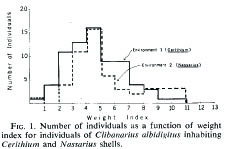Shell Selection in Hermit Crabs
Biology 342 Fall 07
by Matthew Davis & Erin Smith
| Home | Phylogeny | Ontogeny | Mechanism | Adaptive Value | References | Course Home |
Adaptive Value
How Shell Selection Aides Surivival
Suitable gastropod shells are an extremely limiting resource for the population growth of hermit crabs, which produces fierce intra-species competition for quality shells. Furthermore, hermit crabs must have specific shell weight, volume, aperture opening, aperture shape to maximize mobility and protection. Based on these factors, hermit crabs have evolved shell-selecting strategies to maximize fitness.
Optimal Ratio Strategy
Childress (1972) proposed the “optimal ratios strategy” of shell selecting behavior in Clibanarius albidigitus (tropical hermit crab). This proposal is based on the premise that an optimal shell weight/body weight ratio (labeled “weight index”) yields maximum fitness for the individual crab. They measured the most frequent weight index among wild C. albidigitus, which yielded 4-5 as the modal weight index (Figure 1). Next they measured the reproductive fitness of individuals by quantifying the clutch size of females; these values were plotted against the weight index. The females with the largest clutches had a weight index of 4.2, which corresponds with the most abundant wild weight index. They measured behavioral fitness by quantifying aggressive individuals through their encounters with other crabs. The most aggressive individuals had a weight index of 5.2, which is significantly higher than the most frequent weight index. This can be explained due to the extreme rarity of suitable shells, which leads individual crabs to choose a bigger shell yielding a higher than normal optimal weight index. This allows the crab to have some growth period while it continues an extended search for the next suitable shell (your mother may have imposed this strategy on you when buying shoes). The behavior and reproductive weight indexes in this study are the product of the two strategies characterized in the “optimal ratios strategy”, and these behaviors were probably selected for to bring the highest adaptive value for different crabs with different proximate goals (reproductive sucess versus allowing further growth.
 Figure 1.
Figure 1.